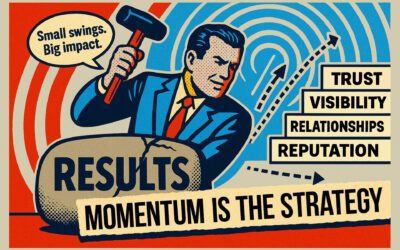The terms strategy and tactics are often interchangeably used when talking about marketing objectives and goals. But while the two words may seem synonymous, they actually mean different things, especially in marketing.
• Strategy is the direction towards the goal you want to accomplish.
• Tactics are the actions taken to support the strategy.
Simply put, strategy refers to the plan to achieve a goal while the tactic is how you execute the plan.
Goals First. Strategy Next. Then Tactics.
In WWII, military Generals spent more than six months mapping out the strategy to win the war in Europe before D-Day. They diagnosed the problem, researched the enemy, pinpointed weaknesses, and literally mapped out a plan of attack. Much of that strategic debate focused on what NOT to do… Where NOT to invade. What battlefields to avoid.
Using the military again as an example:
Goal: Win the war.
Strategy: “Divide and conquer.”
Tactics:
• CIA spies gather intelligence.
• Navy Seals knock out enemy communications.
• Paratroopers secure the airports.
• Armored Divisions race in and divide the opposing army’s forces.
• Drone attacks take out enemy leadership.
• An overwhelming force of infantry invade.
• Hand-to-hand combat.
Why We Do Marketing
Brand Awareness is the level of familiarity that consumers have with a particular brand – its name, characteristics, logo, and anything else that might be strongly associated with it, as well as its goods and services. It’s especially crucial during a brand’s earliest days of formation and growth, as it can indicate and predict market share and differentiation from competitors.
Marketing is the action a company takes to create brand awareness and get your product or service in front of prospects. It’s a series of steps that influence the “buy” decision within your intended audience.
Starting with marketing tactics without addressing marketing strategy first is like building a house without blueprints. It’s based on a strategy of hope which is guaranteed to fail.
When creating a marketing plan, strategy comes first because it deals with the direction of your business growth in relation to your competitors. It is a broad, long-term goal. Next, comes tactical planning, which consists of the actual actions and processes involved in improving your competitive position.
Essentially, marketing strategy is the concept while marketing tactics is the action. Let’s unpack what this involves a bit more.
Marketing Strategy
To gain a competitive edge in marketing, you need a thorough understanding of your target customer’s demographics and buying habits. To decide what your business goals are, you must be up-to-date on industry trends and your competitive position. Once you’ve formulated your goals, you need to develop a strategy to achieve those goals.
Strategic planning involves recognizing the threats and opportunities presented by the industry. What are the strengths and weaknesses of your field? Does your company have the power and financial capability to tackle those threats and grab those opportunities?
Your marketing strategy shouldn’t be all things at once. Focus on an element where you can fill the gap and where you can gain a competitive advantage. This is your unique value or selling proposition. Fulfilling the needs of this industry problem becomes your goal – your strategy.
Strategic marketing considers the long-term goals of your company, such as expanding your business, exploring new demographics, or creating a new brand. Therefore, it needs the insight of your financial department who can analyze if you have adequate funds to realize your goals.
Marketing Tactics
While marketing strategy looks at the goals of the company, marketing tactics focus on the details to achieve that goal. With a strategy in place, the actions or tactics needed to reach your goal can be set into motion.
Creating tactics to support your marketing strategies involve detailed profiles of your customers. Only by knowing your target demographics well can you determine the most effective marketing channels, and choose the right advertising media.
Marketing tactics often involves generating leads, building websites, placing ads, and following up. It includes advertising, sales promotions, and other activities that directly support your strategic marketing plan. And because your strategic marketing plan included establishing a budget, tactical planning preparation should take into account its financial limitations in carrying out these activities.
Strategic marketing and tactical marketing are interdependent and employed in combination. Your marketing plan starts with a strategy and is followed by detailed tactics. The presence of both forms of marketing is essential to the success of your marketing, and the growth of your brand.
How Will You Grow Your Business? Using Strategic Marketing.
Most companies start with marketing tactics by choosing activities such as email, pay-per-click, SEO, social media, trade shows, etc. This is a big mistake!
Starting with marketing tactics without addressing marketing strategy first is like building a house without blueprints. It’s based on a strategy of hope which is guaranteed to fail.
To get the highest impact on your marketing spend, start with strategy, then move to tactics. Strategy drives growth. Ignoring strategy and starting with tactics is like burning a pile of cash in the street.
Final thoughts
A great strategy does not depend on brilliant tactics for success. If the idea is strong enough, you can get by with mediocre tactical execution. (Although I wouldn’t recommend tactical short cuts.)
However, even the best tactics won’t compensate for a lousy strategy. You can waste a lot of money on marketing tactics if there’s no cohesive strategy involved.
Any number of strategies can be used to achieve a business goal. In fact, it often takes more than one strategic approach to achieve a lofty goal, and each strategy involves its own unique tactical plan.
If you’re still wondering about the difference between marketing strategy and tactics, try the “what-if” test…
At Arm & Hammer, they set a goal to increase baking soda sales. Someone asked, “What if we could come up with a bunch of new uses for baking soda?” That’s a strategy because it’s a big idea!
They’re now marketing a whole line of environmentally friendly cleaning products. Every current Arm & Hammer product, from toothpaste to cat litter, originated from that strategy of finding new ways to use baking soda.
As for tactics: All the traditional marketing tactics were employed… TV advertising. Magazine ads. Digital advertising. Search engine marketing. Content marketing. Retail promotions. A website dedicated to all the various uses of Arm & Hammer Baking Soda.
On the other hand, “What if we do search engines?” doesn’t make sense. So it must be a tactic.
“What if we increase market share?” There’s no big idea in that, so it must be a goal.
Just remember this: Goals first. Strategy Next. Then tactics.




